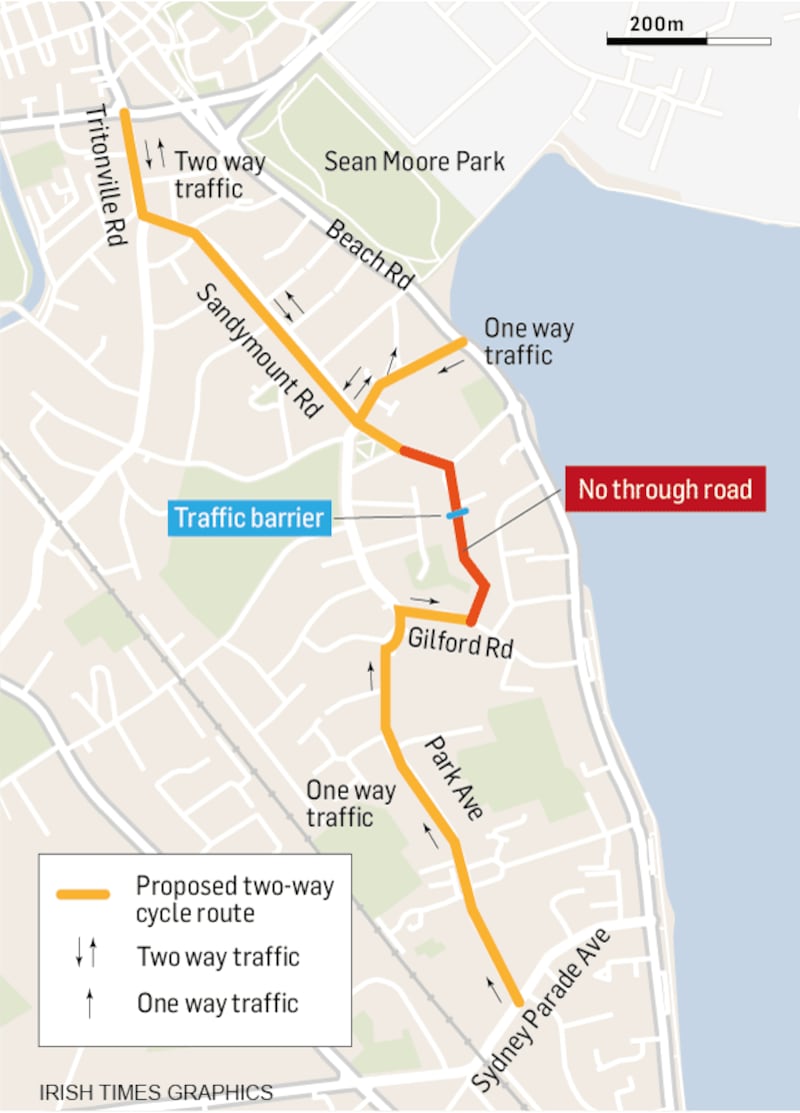We are all in favour of motherhood, apple pie…and cycling. Yes, cycling is a good thing, good for us, good for the environment, something to be encouraged. However, proposals by Dublin City Council (DCC) for Sandymount, on Dublin’s southside, threaten to turn even its most mild-mannered residents against cycling because of a bull-headed approach to imposing a cycleway on one of the main motoring arteries into the city centre.
What is particularly perverse about the DCC plan is that there is a simple, long term, solution that should keep everyone more than happy. However, it is a mystery why it’s not being implemented, and immediately. The current proposal, being imposed by diktat on residents following a wonderfully opaque online ‘public consultation’, is to totally remove the ‘inward’ car lane along the 3km of Strand Road and replace it with a cycle lane.
However, Strand Road is a vital route for traffic in and out of the city centre, to the Port Tunnel, to Dublin airport, to Dublin seaport, to the M4 West and to Northern Ireland. By implication DCC thinks that cyclists will make better use of that particular road resource and is insisting on giving cyclists exclusive road access. But why?
An engineer will tell you how a river should run in theory, according to contour lines, elevations etc. But a local will tell you how the river actually runs, based on daily, year-round physical observations. What local residents (I am one) will tell you is that any diverted traffic will find the nearest rat run. It’s human nature. That will mean that Sandymount, one of the few true villages left on Dublin’s southside, will clog up.
The latest version of the plan (it seems to be being made up as they go along) acknowledges that cars will be forced into the village and seeks to create a 2nd cycle lane through the village; an admission the Strand Road is going to cause massive problems.

A cycle lane will remove temporary parking from the village. The removal of temporary parking would mean local traders - already hit by Covid-19 - may as well pull the shutters down permanently. Spending extra time getting around all the proposed road closures means local drivers will slow traffic further.
The solution lies on or near the water. DCC is planning on spending €250,000 immediately on what is termed temporary traffic management signage etc. If, as I assume, this DCC experiment fails spectacularly, that money is totally wasted, but no one will be held accountable as it was ‘experimental’. A similar ‘experiment’ further south on Seapoint Avenue, towards Dun Laoghaire, is an abject lesson in how ugly plastic modern on-road signage destroys the visual environment.
If DCC were to spend money expanding the promenade that currently runs along some, but not all, of the sea on Strand Road, they would do two things. They would create a long term, sustainable, walkway and cycleway that could run from the South Wall to Williamstown, a lovely 10km walk for all of the city’s residents, that no one could object to. Secondly, if global warming raises sea levels, spending money on stopping the sea flooding parts of Dublin, by pushing the sea away from main roads, would be money well spent.
High tides and strong winds already mean that breaking waves over the seawall on Strand Road makes it dangerous for walkers and cyclists on wild wintery nights. I walk the dog the length of Strand Road every night and there are few if any bikes to be seen. This raises further questions about actual usage figures.
Those in DCC who are forcing the cycleway on their own citizens may very well travel along the seashore on sunny weekends but probably never at 9pm on a winter’s night. Cyclists will use the road during commuting hours and on rare balmy evenings. But that means a dedicated cycle lane will be mostly empty for up to 20 hours a day, a really curious use of one of the city’s rare access arteries.
If the solution appears to be so simple with very little disruption (earthworks along the coastline, well away from roads) why isn’t it being done?
Despite occupying incredible amounts of column inches during a global pandemic we all appreciate Sandymount is not the centre of the universe. However, Patrick Kavanagh put it beautifully in his poem Epic when he wrote,”I made the Iliad from such a local row. Gods make their own importance.”
Conall Ó Móráin is co-host of the That Great Business Show podcast














